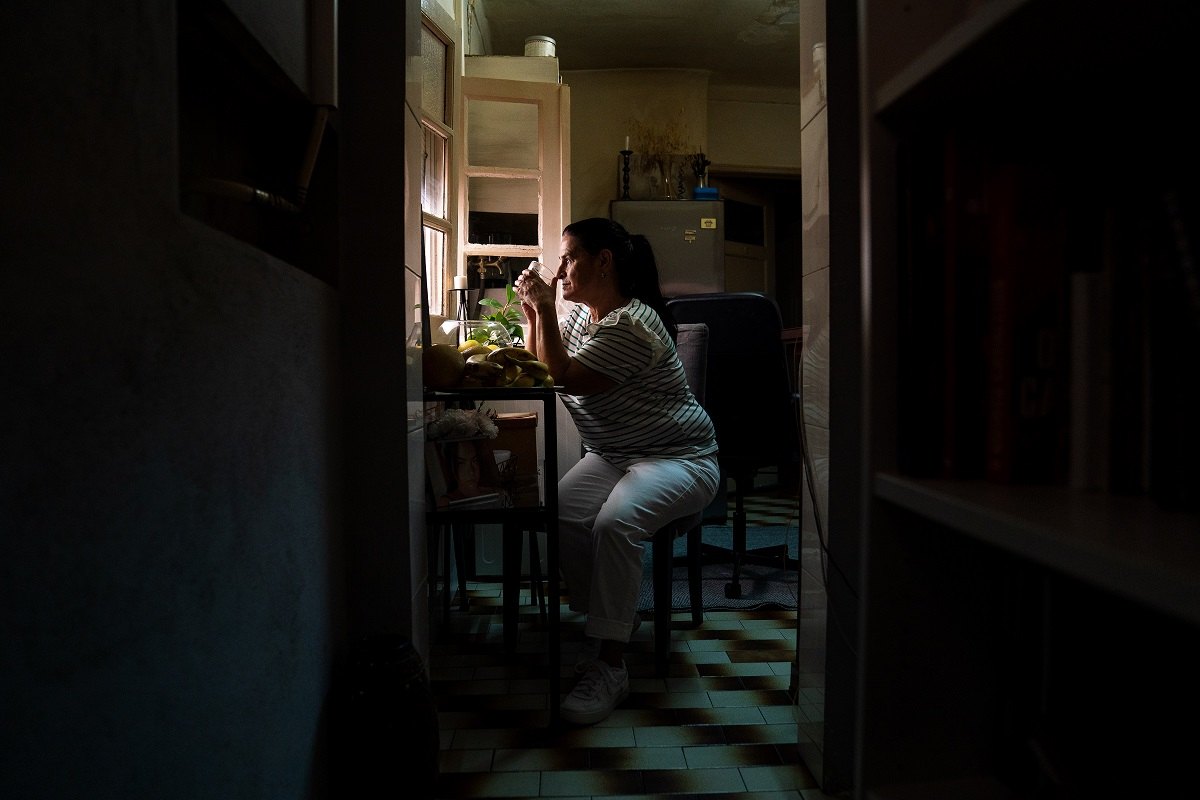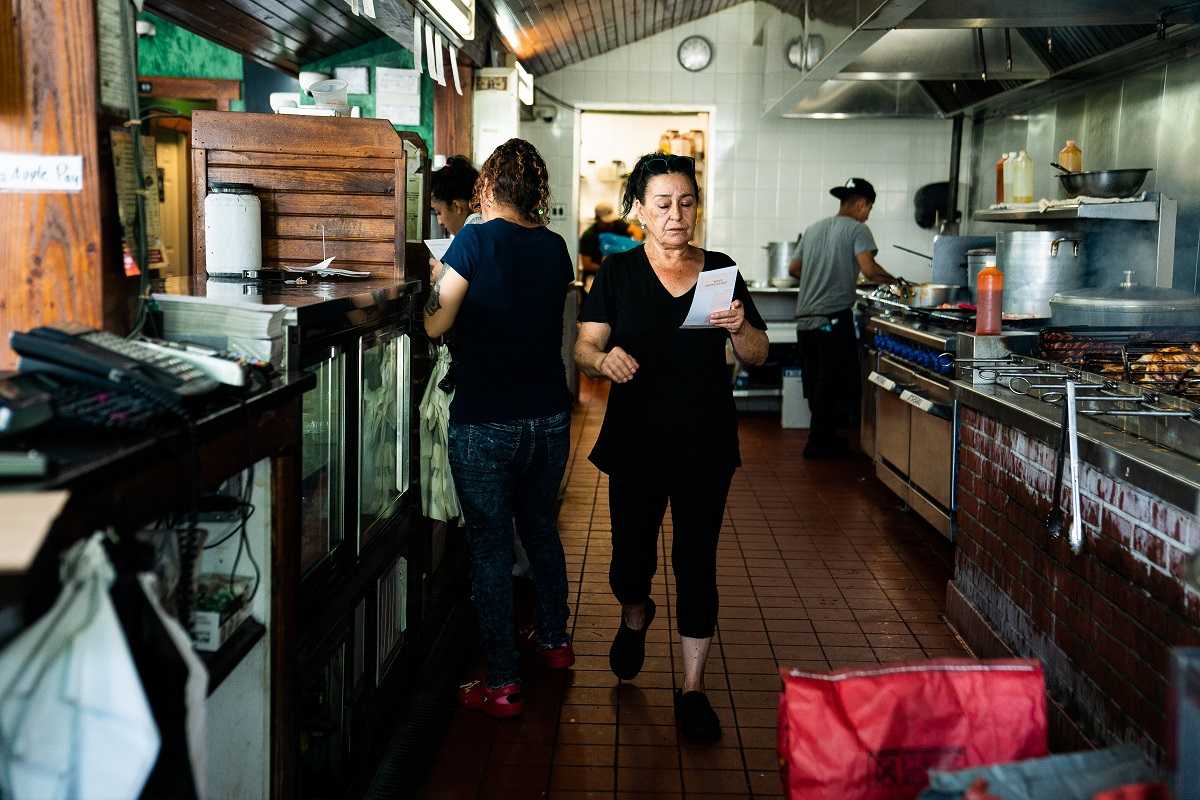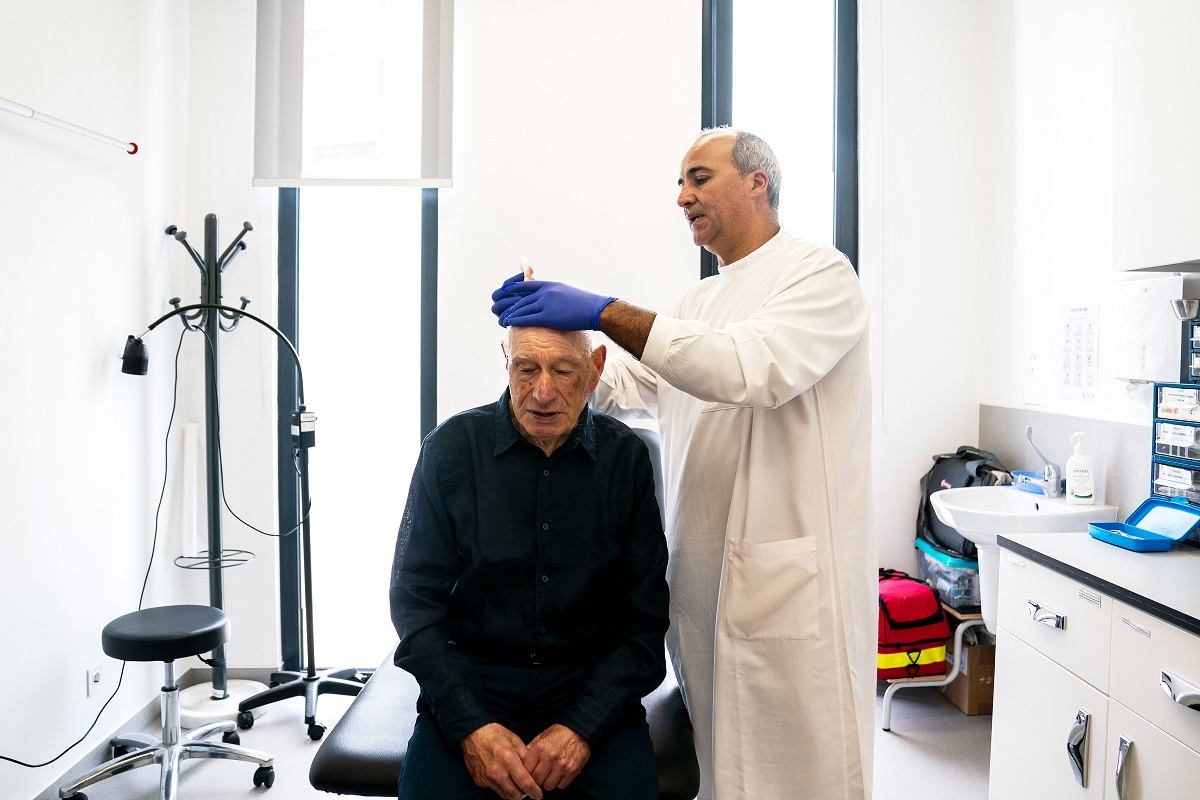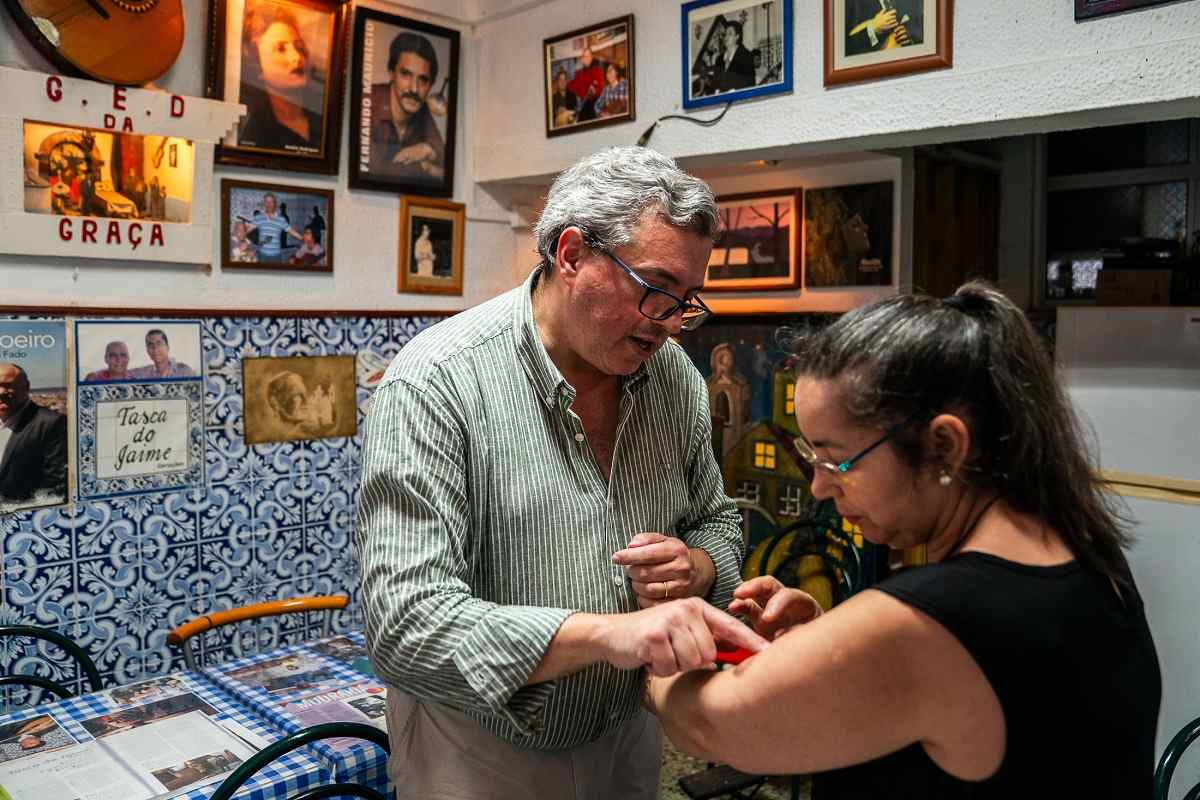
The hilly roads of Lisbon provide scenic exercise opportunities for city residents.
16:56 JST, October 29, 2023
LISBON – On days when the pain in her feet is so intense that she has to crawl from her bedroom to the bathroom, Lucilia Costa longs for her older sister, more than 3,000 miles away across the Atlantic Ocean.
“Sometimes, I call her just to cry, because she understands what I feel in that moment,” Lucilia said.
They commiserate over the agony of swollen joints. They discuss the drugs both keep in boxes by their beds. And they talk over the treatment they receive to keep the cruel bouts of rheumatoid arthritis at bay.
That’s where the Costa sisters’ shared stories suddenly diverge.
Almost all the care that Lucilia, 58, receives is carefully coordinated through Portugal’s Serviço Nacional de Saúde – the National Health Service – which puts a premium on universal access to primary care. Her sister Lurdes, 66, has cobbled together her treatment in the United States, paying some doctors out-of-pocket or showing up at the ER when her symptoms flare, and sometimes returning to her native Lisbon for more-affordable care.
On trips she made there before the coronavirus pandemic, Lurdes stocked up on prescription drugs and scheduled routine screenings, including mammograms and a colonoscopy.
“I don’t know what would have happened if I couldn’t go to Portugal,” said Lurdes, who has lived in New Jersey for almost 40 years. “I was really, really sick.”
The sisters’ experiences highlight structural and philosophical contrasts between the two systems – differences that put Portugal, a country of more than 10 million with a relatively small economy, among the nations with the best “population health” outcomes in the world. Overall, experts said, Portugal provides a promising if imperfect model for reaching at-risk residents early and tackling the chronic illnesses that drag down a nation’s life expectancy.
Portugal’s temperate climate, healthful diet and communal culture play vital roles in people’s well-being. There are also greater restrictions on guns. Personal drug use has been decriminalized, allowing opportunities to treat rather than stigmatize addiction. And there are more physicians per person than in the United States.
The Portuguese suffer many of the familiar life-limiting challenges of the modern world, including cancer, cardiovascular disease and growing rates of obesity. Even with those, experts cite a seminal factor boosting the country’s position in the longevity stakes: In Portugal, as in other countries such as Chile and Costa Rica, advances in life expectancy have coincided with a focus on population-wide access to comprehensive entry-level care.
“One thing that is clear to me: The countries that do well nearly always have early and sustained commitment to primary care and public health investment in their communities,” said Atul Gawande, a surgeon and public health expert who is working to identify and implement low-cost, high-impact health interventions as the assistant administrator for global health at the U.S. Agency for International Development.
Gawande and other experts contrast high-cost with high-value care. The United States spends 18.3 percent of its gross domestic product – and more per person than any other country – on its state-of-the-art, sickness-focused system. Yet it is experiencing a decline in life expectancy to 76.4 years in 2021, the shortest in almost two decades. Portugal, by contrast, spends about one-fifth as much per person, yet life expectancy here has advanced to 82, six months longer than the European average.
A key factor is that Portugal spends its health-care funds on an integrated approach to primary care, including clinics for most essential needs and, crucially, community outreach to identify vulnerable people before they become gravely ill.
“We are efficient,” said Luis Pisco, a family doctor who retired in August from his position as president of the board of the health system here in Lisbon and the Tagus Valley, one of Portugal’s five regional health administrations. “We cannot say we are perfect. But for the money we spend, we get good results.”

Lucilia drinks a cup of ginger tea to help reduce her arthritis pain.
‘They care about me’
Portugal’s National Health Service came into being almost half a century ago. Despite periods of upheaval over standards of care and salaries, which are now prompting protests, it is still extolled by many as an example of the enlightened thinking that emerged from the country’s transition from a dictatorship to a democracy. The 1976 constitution established every citizen’s right to health care, regardless of ability to pay.
Many of the system’s key efficiencies stem from a 2005 program Pisco spearheaded to promote primary-care access by creating Unidades de Saúde Familiar – autonomous family health units. These small, multidisciplinary teams of family doctors, nurses and clinical secretaries are embedded in communities, and are the cornerstone of Lucilia’s care. The teams contribute to functions Americans typically associate with state and local public health departments, such as disease surveillance and health education, as well as gathering data on treatment protocols and outcomes.
“We can see what we are doing almost in real time,” said André Biscaia, a family doctor and president of the association of family health units. “We can make corrections when things are not going the way we want.”
That big-data approach is made possible by regular input across the national network from individual cases like Lucilia’s. In the United States, by contrast, Lurdes has had to navigate a patchwork system, leaving a trail of poorly coordinated medical records with different doctors at different hospitals, some even overseas.
Not only does that result in a loss of systemwide data but it complicates care for patients with complex diseases like rheumatoid arthritis – RA – who often need to see a range of specialists.
RA attacks the immune system, causing unpredictable bursts of crippling pain. If inflammation goes unchecked, it can be deadly, particularly when it attacks the heart or lungs. The disease accelerates the aging process and shortens people’s lives, which are often punctuated by a bewildering slew of symptoms, including skin rashes, severe infections and increased stress. Lucilia worries about going out in public; Lurdes is scared of being left alone.
“I am the opposite of my sister – I don’t like to be at home,” Lurdes said, sitting in the kitchen of her one-bedroom apartment in Union, N.J., which is decorated with lush landscapes she painted to keep her mind at rest.
The Costa sisters were both living in the United States when they developed RA symptoms about 15 years ago. They were working long hours providing in-home care, cleaning houses and waiting tables – physically strenuous jobs that did not offer insurance. Neither sister felt she could shell out several hundred dollars a month for private coverage.
Lucilia recalls coming down with pneumonia and being admitted to a northern New Jersey hospital for a week, during which she saw countless specialists before receiving a diagnosis of RA – along with a bill for thousands of dollars, she said, which she could not pay.
For Lurdes, the onset was more gradual – a mix of flu-like illnesses, swollen hands and hives that sent her in search of pricey care from private doctors or to the ER, where she would fill out forms showing she did not have the means to pay for treatment.
“I was never abandoned,” Lurdes recalled. “They always looked after me.”
But the costs of letting a chronic illness develop into a crisis are substantial, both to the system and to a patient. It is up to 12 times as expensive to treat patients in the ER as in primary-care settings, amounting to billions of wasted U.S. health-care dollars every year. Treatment for many chronic conditions, including RA, not only alleviates the immediate symptoms but also slows the disease’s progression. And despite having an understanding employer who allowed her to take time off, Lurdes describes the challenges of lurching between sickness and health.
“I can’t make plans because today I am okay, tomorrow I cannot walk,” she said.
Seven years after her diagnosis, in an unhappy marriage and increasingly disabled by her disease, Lucilia returned to Portugal and enrolled in the National Health Service. Her primary-care physician now plays a pivotal role in a team that includes a gastroenterologist, a psychiatrist and an internal medicine specialist who offers his patient emotional support along with technical expertise, embracing her when she comes in for appointments and accompanying her to have blood drawn.
“They care about me. They protect me,” Lucilia said, shedding tears as she contrasted the skilled but short-term rescue care she experienced in America with the ongoing support she receives from her Portuguese doctors. “I feel when I am in bad shape, they give me strength.”
Lurdes stayed in the States, sending home as much as $250 a month to support her sister and their mother, as well as providing for a now-grown daughter she left behind when the child was 3. “I had to work seven days a week for many, many years,” Lurdes said.
Her partner, Beto, nursed Lurdes through the ordeals, carrying her to the shower and bringing her food. But he was also uninsured, trying to manage his diabetes by reducing the weight he had gained since immigrating to the United States, and suffering from discomfort in his groin that proved to be a bulging hernia.
Five years ago, as Lurdes’s symptoms worsened, a doctor gave her a piece of advice: Without consistent treatment, there was nothing to stop each bout of inflammation from further damaging her body, she recalls the doctor telling her. She should fly home to consult a Portuguese rheumatologist and get her prescription medications there. Lurdes, who traveled in off-peak season to save on costs and paid about $65 to see a specialist in Lisbon privately, said she still grapples with her predicament.
“I think it’s [a] shame I have to go over there and get doctors, and I work hard in this country,” she said.

Lurdes takes a delivery order at Burnet B.B.Q. IV in East Orange, N.J.
Similar challenges, different solutions
Portugal is facing many of the same health challenges as the United States, according to the European Commission’s 2021 analysis of the “State of Health” in its constituent countries. Its population is aging. Noncommunicable conditions such as cancer and cardiovascular disease are among the leading causes of death. And behavioral risk factors play a role in about one-third of deaths, with the familiar scourges of obesity, smoking and sedentary lifestyles contributing to a growing public health threat. In 2018, almost one-quarter of Portuguese 15-year-olds were overweight or obese, according to data from the Organization for Economic Cooperation and Development, a policy forum for member countries committed to democracy and the market economy.
Still, far fewer people in Portugal than in the United States reported that their medical needs were unmet because of cost, distance or waiting time. In 2019, even in the lowest-income group, just 3.5 percent of people said those factors stood in the way of their getting care, according to European Union statistics on income and living conditions.
In the United States in the same year, 12.1 percent of people delayed or did not receive needed care because of financial constraints alone, according to data from the Centers for Disease Control and Prevention. The numbers rose to about 15 percent among Black and Hispanic people.
In Portugal, part of the success may stem from the high number of doctors for the population size. In a recent tally of physicians per person among its 38 member countries, the OECD found that Portugal topped the list, with 57 doctors per 10,000 residents; roughly half are generalists. By contrast, the United States has 27 doctors for every 10,000 residents, the vast majority of whom are highly paid specialists.
Another factor may be the decision to put the health system at the forefront of tackling a pervasive killer: drugs. The country’s 2001 move to decriminalize all drugs for personal use has erupted recently in controversy, but many Portuguese doctors argue that their approach affords a chance to treat addiction before it ravages entire communities. There are many variables at play, but the discrepancy in deaths is striking: Commonwealth Fund data shows that in 2021, 11 Portuguese residents per million died of overdoses, while in America the figure was more than 450 per million.
As in many countries with nationalized health services, residents can choose to seek treatment outside the largely taxpayer-funded system.
People in certain occupations, such as civil servants, pay a percentage of their salary to access care through subsystems of the National Health Service. And more than 30 percent of the Portuguese have voluntary private health insurance plans, which cost on average a little more than $300 a year. Many people choose to use more than one system, although for emergencies, ambulances are routed directly to public hospitals.
Many people pay to access dental consultations, some diagnostic services, dialysis and rehab in the burgeoning private sector, which offers a wide range of care, particularly in major cities. But the National Health Service, with primary care at its core and a comprehensive array of specialists, remains the backbone of the health system, setting Portugal apart from the United States and even from some of its European neighbors.
The United States spends just 5 percent of its health-care dollars on primary care, a field that is attracting fewer and fewer applicants. In Europe, that figure is closer to 15 percent. Portugal dedicates a bigger share of its health budget – close to 50 percent – to outpatient care than any other E.U. country.
OECD data shows that Portugal is performing better than other European countries in avoiding hospital admissions for chronic conditions such as asthma, diabetes, chronic obstructive pulmonary disease and congestive heart failure.
Residents also continue to reap the benefits of the country’s transition to democracy and its subsequent admission to the E.U. Between 1974 and 2014, life expectancy at birth rose by about 14 years, as those political shifts ushered in improvements in basic needs such as clean water and funding for new infrastructure.
Even in the poorer parts of Amadora, the Lisbon suburb where Lucilia now lives, the family health center stands out as a welcoming beacon, with a freshly painted brick-red facade and carefully tended plantings by the door.
In rural areas, the health centers are often modern structures. In the fishing town of Nazaré, 75 miles north of Lisbon, patients take seats in a light-filled waiting room before being called into the corridor of consultation rooms, where many engage in steady jovial banter with their health-care providers, some of whom they also encounter in stores and restaurants.
The health centers are designed to manage most maternal and child health needs, including vaccinations and family planning, as well as minor trauma, chronic conditions such as diabetes, and screenings for cancer and infectious diseases including HIV and tuberculosis. Since the 2005 overhauls, the uptake for breast and cervical cancer screenings has increased to well above the European average, potentially because they are done by family doctors in familiar settings.
Luis Amaro, 50, has spent his entire life in Nazaré, where he is one of the seven nurses who work with seven doctors to provide primary care to the community of 12,000.
“The population loves us,” Amaro joked, as he pulled on white gloves to check a head wound on an 81-year-old man, a former journalist he has known for almost 20 years. “And if they love us, we love them.”

Nurse Luis Amaro changes the bandages of Joaquim Vasco da Silva, 81, during an appointment at the Nazaré health center.
A festival of love and sardines
Portugal’s commitment to community-wide health care builds on cultural attitudes that predate the creation of the National Health Service in the 1970s, according to Maria Clara Calheiros, a professor of law at the University of Minho. In studies comparing countries’ cultures, Portugal stands out for its collectivism, she said, in contrast to America’s emphasis on individualism.
“People are interested in the well-being not of themselves as individuals but of the group they belong to,” Calheiros said. “The family. The people in their parish. Their village. The neighborhood. Their city, region and so on.”
Preserving those cultural norms has become a calling for many family physicians, who see them as a means of fending off the toxic brew of processed foods and sedentary lifestyles shortening lives around the globe.
“That is the basis, to have a long-term plan with your patient to prevent chronic disease,” said João Sequeira Carlos, a family doctor in Lisbon.
On a Saturday in mid-June, at the height of Lisbon’s summer festivals, Sequeira Carlos climbed some of the city’s steepest streets, pointing out ways the country’s landscape and traditional diet, rich in fish and fresh vegetables, can be used to keep the population healthy.
“We can prescribe walking in the seven hills of Lisbon for an hour every day,” said Sequeira Carlos, emphasizing that in addition to bringing metabolic and cardiovascular benefits, residents interact with their neighbors instead of spending money on a gym.
Sequeira Carlos’s first stop that summer evening was to join his wife, a palliative care physician, for dinner at Tasca do Jaime, a blue-tiled, 20-seat restaurant owned by Jaime and Laura Nunes, who have been his patients for almost two decades.
For several hours, the two couples shared stories of their growing children, holding hands like old friends and taking breaks to listen to the nostalgic Portuguese folk music known as fado. Laura Nunes brought out photographs of a 10-year-old grandchild whose parents are also among Sequeira Carlos’s patients, and he briefly examined bruising on his patient’s arm. As her family physician left, Laura Nunes pressed gifts of olive oil and cornbread into his hands.
Sequeira Carlos and his wife went on to Lisbon’s Santo Antonio celebration, an annual event when the city’s ancient alleyways erupt in riotous dancing and strangers feast side by side on trestle tables.
The pungent smell of grilled sardines saturated the evening air, clinging to people’s clothes as restaurant owners expanded their kitchens into the narrow streets with makeshift grills to serve thousands of revelers a standard menu: freshly caught sardines, green salads with sweet peppers and cornbread.
“Look at what they’re eating! High in omega-3!” Sequeira Carlos said, laughing, as the couple wove their way through the dancing crowds, swaying to the singing and joining in familiar lyrics that spoke of love in honor of St. Anthony, a 13th century Catholic priest who became the patron saint of marriage.
The festival highlights the healthful options regularly available to Portuguese people even in impoverished communities. Urban food deserts are unheard of here. On her 15-minute walk to the health center in Amadora, Lucilia passes convenience stores displaying racks of locally grown vegetables alongside batteries, cold drinks and cleaning products. Her tiny apartment is stocked with fresh fruit.
In New Jersey, Lurdes is doing her best to keep those traditions alive. She has planted herbs and tomatoes in pots outside her apartment and takes pride in the lightly dressed salads and traditional bean-and-vegetable soups she serves at Burnet B.B.Q. IV, the Portuguese American restaurant where she works. But the menu has had to adapt to American tastes, with bigger portions, more french fries and slatherings of barbecue sauce on plates of ribs.
Lurdes thought back to the Portuguese preference for a little hot sauce on grilled meats and smiled.
“The American customers, they like it sweeter,” she said.

Family doctor João Sequeira Carlos speaks with longtime patient Laura Nunes about a bruise on her arm while dining at her Lisbon restaurant.
The value of community care
Portugal’s emphasis on collective well-being is in full effect less than a mile downhill from the ancient streets that host the Santo Antonio festivities, at the Baixa family health center. The facility is known for its outreach to marginalized communities, including many immigrants who might otherwise not get care until they are in crisis.
“We take care of all the residents,” said Biscaia, president of the association of family health units. “Even if they are illegal, we treat them the same way. If you don’t approach the whole population, you are not going to have good results.”
Shattered glass at the entry reflects how rough the neighborhood can be at night, but inside there is well-ordered calm. Colored lines painted on the floors keep nonnative speakers on track to the appropriate part of the building for treatment, for maternal or pediatric health care, or to see the family doctor.
These health-care providers are at the forefront of projects such as “social prescribing” – connecting patients to social workers and other community services to head off problems before they become acute. That integrated, population-wide approach is key to Portugal’s strikingly low hospitalization rates compared with other OECD countries.
The philosophy paid off during the coronavirus crisis, when Portugal became a beacon for vaccine success. By September 2021, 18 months into the pandemic, 85 percent of the population was fully vaccinated and the death rate from covid-19 was half the European average, and nine times as low as that of the United States.
The commitment to outreach also has benefits on a more personal level, for patients like Lucilia.
When her pain leaves her writhing in bed, unable to twist the cap off a bottle of water, Lucilia said, her doctors often call to check on her.
On Christmas Day, her cellphone rang. She was surprised to hear her psychiatrist speaking. He wasn’t working that day, but he was concerned she might be indulging in Mon Chéri chocolates, a traditional seasonal treat but one that carries special risks for Lucilia because the cherry-brandy filling could interact with drugs she takes.
“He was worried about me having candy!” Lucilia said.
The rising cost of living, particularly around Lisbon, has put pressure on the National Health Service. Twenty-four percent of people in the Lisbon and Tagus Valley administrative region do not have family doctors. Many physicians have chosen to go into private practice.
“I am an example of that,” said Sequeira Carlos, who now heads the general practice and family medicine department at Hospital da Luz, Lisbon’s biggest private hospital. The Nunes family chose to pay a monthly fee to follow him rather than try to build the same level of intimacy with a new National Health Service doctor, although they can still access the public system. Some people use the NHS, the subsystems and their private insurance, which runs the risk of redundant and fragmented care, Sequeira Carlos said.
Waiting lists at public hospitals for procedures that aren’t urgent, such as joint replacements and even fractures, prompt transfers to private facilities. A few days after his visit to Tasca do Jaime, Sequeira Carlos heard from a friend who had waited five days to have surgery on a hip fracture before transferring to a private hospital.
“A system that was a model for the world is facing problems,” said Pisco, the family doctor who until recently oversaw the Lisbon and Tagus Valley administrative region – an organizational structure that will alter under the latest round of changes announced by the Health Ministry. The complaints Pisco hears today remind him of the dissatisfaction that prompted the 2005 overhauls.
The battle over health care has become politicized, as it was back then. People march in the streets, complaining about the taxes and user-fees they pay for imperfect care. Doctors are striking for higher pay. Newly qualified physicians are choosing more-lucrative work in the private sector or abroad. And private clinics are springing up on city streets, advertising easy access to their family doctors.
Even in the expanding private sector, primary care is viewed as a key to coordination and keeping down costs. Hospital da Luz has embedded a team of primary-care physicians close to the hospital entrance.
“We are the gatekeepers,” said Sequeira Carlos, as he showed off the gleaming white suite of offices where he holds consultations with his patients, and is available to head off unnecessary ER visits and to consult with specialists should one of his patients be admitted.
Both he and Pisco say that the public and private systems need to coexist, and that primary-care doctors should be available overnight and on weekends, preventing people from showing up at ERs with concerns that could be managed more efficiently by family physicians.
Aging populations bring new challenges, including the possibility that people living into their 80s will have one or more chronic conditions for half their lives. That will increase the need for interventions to address living conditions and behaviors that affect health before anyone goes to the doctor, said Sonia Dias, a professor at the National School of Public Health in Lisbon. Studies show that by far the largest contributor to people’s health – at least 80 percent – is not actual medical care but the social and environmental factors that the teams at Baixa are trying to influence by deploying community social workers.
“If we think of the sustainability of the health sector, costs for the future of chronic illness and an aging population, we know the health sector alone will not be able to solve the issues,” Dias said.
‘Her dream is to come back’
In the future, both Costa sisters know, they will need community support as well as accessible health care.
At 66, Lurdes can access regular appointments through Medicare, the U.S. government insurance program for people 65 and older. However, she remains acutely aware of the vulnerabilities that come from falling ill in America.
In late June, she got a call she had been dreading: Beto, her partner, was in an ambulance, heading to the hospital for emergency surgery on the hernia he had left untreated.
And even under Medicare, Lurdes says, her medication is sometimes delayed because of confusion over the authorization processes, leading to rashes and painful swelling of her hands.
Incidents like those have persuaded Lurdes to retire to Portugal, where Beto still owns property. They won’t be rich, she said, but they will have the support they need, particularly if her health deteriorates.
Lucilia feels sure it is the right decision. For them all.
Her tone brightens at the thought of her sister’s return, certain that whatever Lurdes gives up in terms of U.S. earnings will be more than matched by the benefits of growing old together in a country that guarantees them both comprehensive care.
“I know her dream is to come back,” Lucilia said. “And in terms of health care, she would be much better here.”
"News Services" POPULAR ARTICLE
-

American Playwright Jeremy O. Harris Arrested in Japan on Alleged Drug Smuggling
-

Japan’s Nikkei Stock Average as JGB Yields, Yen Rise on Rate-Hike Bets
-

Japan’s Nikkei Stock Average Licks Wounds after Selloff Sparked by BOJ Hike Bets (UPDATE 1)
-

Japan’s Nikkei Stock Average Buoyed by Stable Yen; SoftBank’s Slide Caps Gains (UPDATE 1)
-

Japanese Bond Yields Zoom, Stocks Slide as Rate Hike Looms
JN ACCESS RANKING
-

Keidanren Chairman Yoshinobu Tsutsui Visits Kashiwazaki-Kariwa Nuclear Power Plant; Inspects New Emergency Safety System
-

Imports of Rare Earths from China Facing Delays, May Be Caused by Deterioration of Japan-China Relations
-

University of Tokyo Professor Discusses Japanese Economic Security in Interview Ahead of Forum
-

Japan Pulls out of Vietnam Nuclear Project, Complicating Hanoi’s Power Plans
-

Govt Aims to Expand NISA Program Lineup, Abolish Age Restriction



















